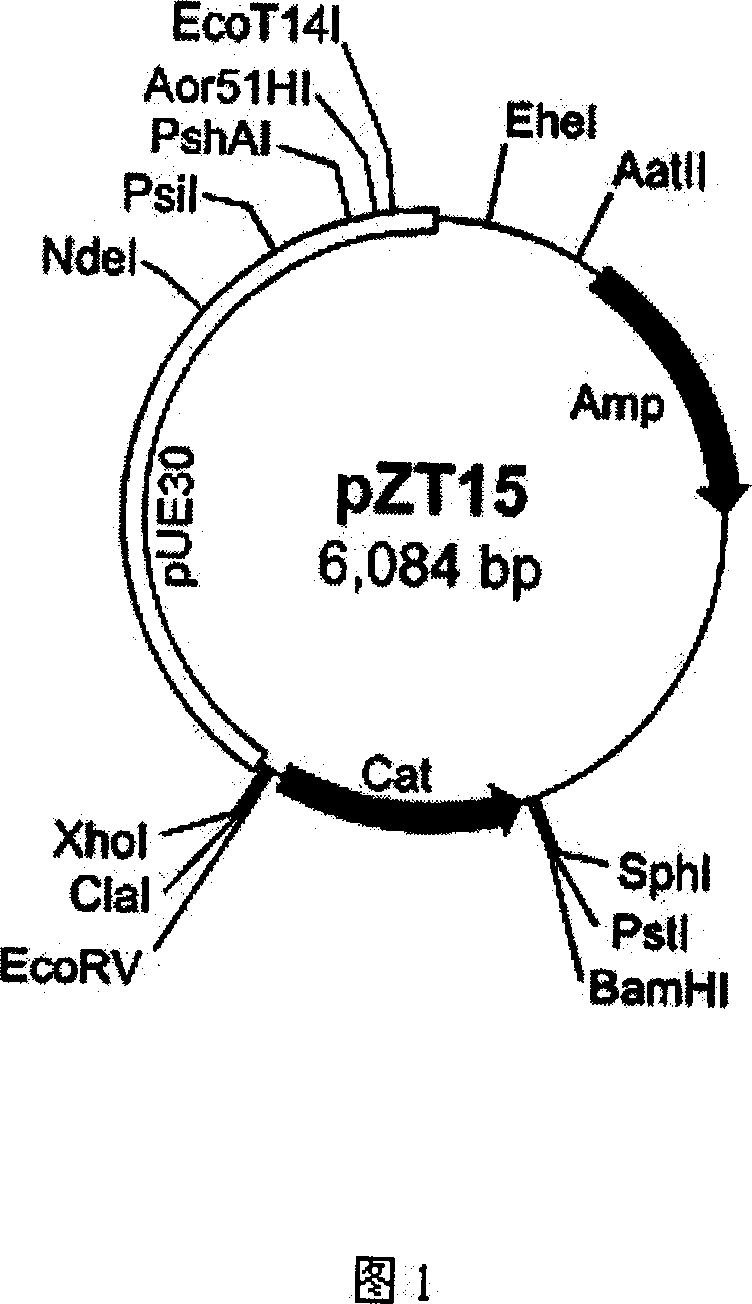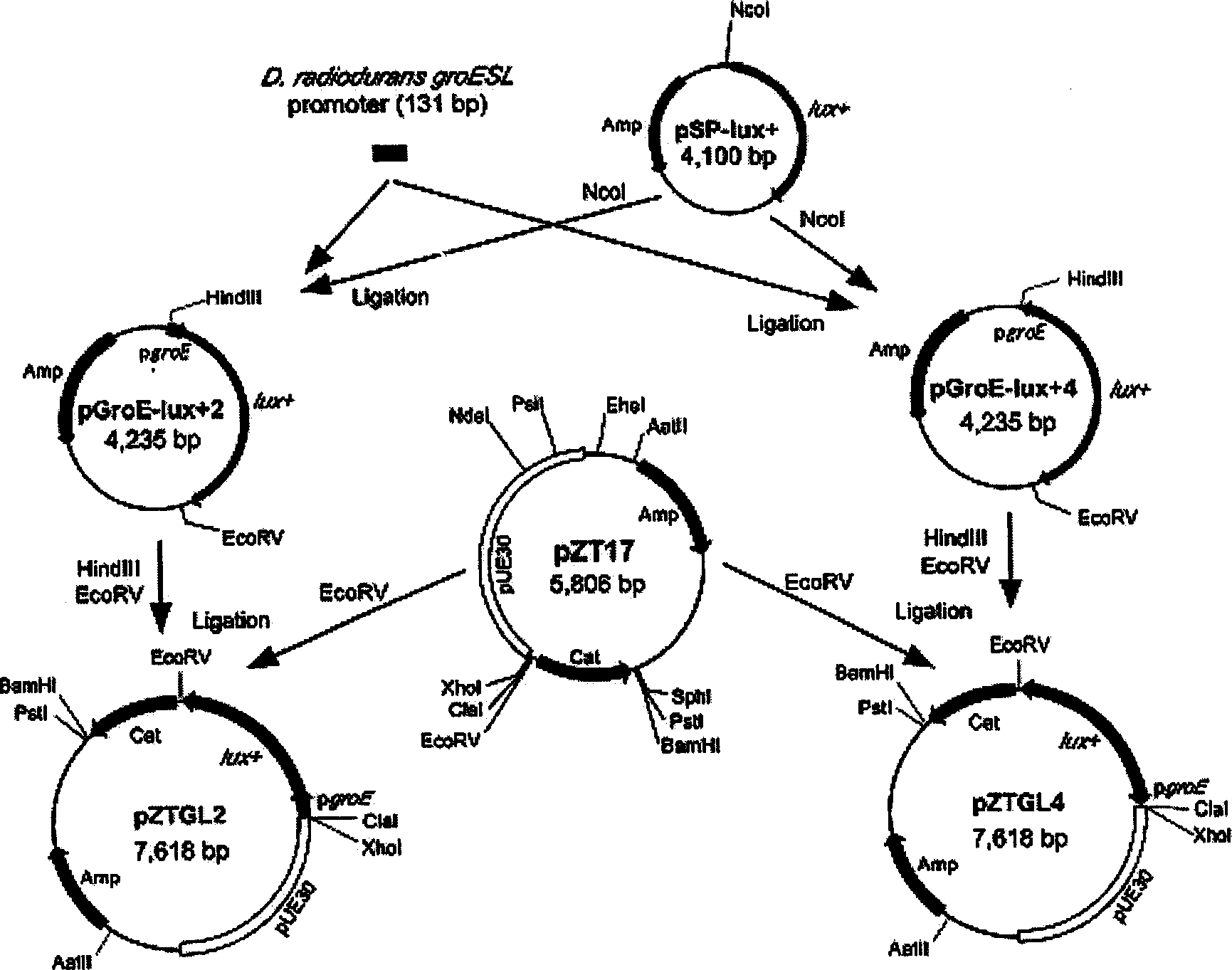Shuttle vector between antiradiation bacterium and colibacillus and its construction process
A technology of Escherichia coli and anti-radiation bacteria, applied in the biological field, can solve the problems of inevitable pollution of the environment, difficulty in resisting biological substances, and inability to control copy number, etc., and achieve the effect of wide application prospects
- Summary
- Abstract
- Description
- Claims
- Application Information
AI Technical Summary
Problems solved by technology
Method used
Image
Examples
Embodiment 1
[0029] Example 1: Preparation of plasmids
[0030] (1) Isolation and purification of plasmid
[0031] The radioresistant bacterium Deinococcus radiopugnans ATCC19172 was cultured with TGY medium (containing 0.5% tryptone, 0.1% glucose, and 0.3% yeast extract), and the cells were collected by centrifugation. Plasmid components were extracted with QIAfilter Plasmid kit (QIAGEN, Germany), separated and purified by agarose gel electrophoresis, and a plasmid of about 2.45 kb was found. Mackay et al. (Arch. Microbiol., 141:91-94, 1985) observed the radiation-resistant bacteria Deinococcus radiopugnans with an electron microscope and reported the presence of a plasmid pUE30 with a size of about 2.5 kb. Therefore, the purified plasmid of 2.45 kb was isolated as pUE30 this time.
[0032] (2) Determination of base sequence
[0033] The restriction map of the refined pUE30 above was made, and it was found that there was a restriction site for HincII and Aor51HI in pUE30 respectively. ...
Embodiment 2
[0034] Embodiment 2: Construction of shuttle vector pZT15, pZT17
[0035] (1) Construction of pZT15
[0036] Using pUE30 as a template, DNA synthesized from the base sequences shown in SEQ ID NO: 2 and SEQ ID NO: 3 (designed by yourself based on the base sequence of pUE30 above) as primers, and using AmpliTaq Gold DNA polymerase (AppliedBiosystems) for PCR reaction , to obtain a PCR product with a restriction endonuclease SphI site designed at both ends and a complete base sequence of pUE30. Next, the plasmid pKatCAT (Funayama et al., Mutat.Res ., 435:151-161, 1999), and then mixed with the SphI digest of the above PCR product, and ligated with DNA ligase. The above linker was transformed into Escherichia coli JM109 strain by electroporation. A strain with a plasmid (about 6.1 kb in size) connected with pUE30 and pKatCAT was selected from the Amp-resistant transformant, and the plasmid was named as the shuttle vector pZT15. The structure of pZT15 is shown in Figure 1.
[0...
Embodiment 3
[0039] Example 3: Verification of the properties of the shuttle vectors pZT15 and pZT17 of the present invention
[0040] (1) Recombinant transformation of the radioresistant strain Deinococcus grandis ATCC43672 using a shuttle vector
[0041] Use the above-mentioned shuttle vector pZT15 or pZT17 to recombine transform the radioresistant bacteria Deinococcus grandis ATCC43672 strain, and refer to the method of Kitayama et al. 2 Law. No matter using pZT15 or pZT17 shuttle vector, strains containing chloramphenicol resistance gene can be obtained. Plasmid components were extracted from these strains using the QIAprep Miniprep Plasmid kit (Qiagen), and analyzed by agarose gel electrophoresis, and it was confirmed that the introduced plasmid remained in the recombinant transformant.
[0042] (2) Stability verification of the shuttle carrier in the radioresistant bacteria Deinococcus grandis
[0043] Cultivate the radioresistant bacterium Deinococcus grandis containing the shutt...
PUM
 Login to View More
Login to View More Abstract
Description
Claims
Application Information
 Login to View More
Login to View More - R&D
- Intellectual Property
- Life Sciences
- Materials
- Tech Scout
- Unparalleled Data Quality
- Higher Quality Content
- 60% Fewer Hallucinations
Browse by: Latest US Patents, China's latest patents, Technical Efficacy Thesaurus, Application Domain, Technology Topic, Popular Technical Reports.
© 2025 PatSnap. All rights reserved.Legal|Privacy policy|Modern Slavery Act Transparency Statement|Sitemap|About US| Contact US: help@patsnap.com



